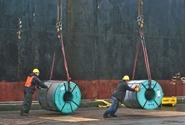Economy

End of January Shipping Update
Written by Sandy Williams
January 31, 2015
Barge activity on the lower Mississippi remains strong. Winter weather has hindered freight movement in a few northern regions and barge availability is tight in some areas, according to the latest MID-SHIP Report.
Northbound barges are showing strong steel and salt cargoes. Stevedores have been working vessels as they arrive in New Orleans and elsewhere in the Gulf and East Coast.
SMU received an update on Port of New Orleans conditions last week, noting that breakbulk and container shipments were up by more than 30 percent in 2014. Much of the breakbulk increase was due to higher volumes of steel imports in 2014. A majority of steel imports are loaded directly to barges, said Matt Gresham, Director of External Affairs at the Port of New Orleans, which reduces warehousing costs and saves time. New Orleans expects strong steel and project cargos to continue in the coming months.
The American Trucking Association (ATA) reported the turnover rate at large truckload carriers rose one point to an annualized rate of 97 percent in Q3 2014.
“Driver turnover, which is a good barometer of the driver market, remains high,” said ATA Chief Economist Bob Costello. “While it is not approaching its historic highs of the early 2000s, continued economic growth and increased freight demand will continue to exacerbate the shortage of drivers many sectors of the industry are witnessing.”
DAT Solutions reported load volume fell 19 percent in the week ending January 24. Truckload capacity gained 15 percent, reducing load-to-truck ratios. Flatbed capacity gained 14 percent. Flat bed rates fell 4¢ per mile to $2.21 per mile, including a 1¢ decline in average fuel surcharge. The national average for diesel fuel fell 6¢ to$2.87 per gallon.
The Cass/INNTRA Ocean Freight Index reported a 32 percent increase container imports in December. Imports from China increased nearly 50 percent. Ship owners continue to suffer serious losses as low rates and diminished demand persists. The Baltic Index Dry Index hit a 28 year low this week, dropping by more than 50 percent in the last three months. As of January 30, the Baltic Dry Index, which measures shipping costs for dry bulk commodities like coal, iron and grain, stood at 632.00.
Total weekly rail traffic for the week ending January 24 was up 4.1 percent year compared to the same week in 2014, according to data released by the Association of American Railroads. Intermodal volume was 253,317 containers and trailers, an increase of 3 percent year over year. Nine of the ten carload commodity groups increased with coal shipments leading with at 3.8 percent jump. Metallic Ores and metals rose 2.8 percent year over year while petroleum increased just 0.8 percent.

Sandy Williams
Read more from Sandy WilliamsLatest in Economy

Architecture billings continue to slide in March
Architecture firms said billings continued to decline in March, according to the latest Architecture Billings Index (ABI) released by the American Institute of Architects (AIA) and Deltek.

Beige Book shows concerns about trade policy
Manufacturing was mixed, but two-thirds of districts said activity was little changed or had declined.

New York state manufacturing index drops again in April
Firms were pessimistic, with the future general business conditions index falling to its second lowest reading in the more than 20-year history of the survey

Construction adds 13,000 jobs in March
The construction sector added 13,000 jobs, seasonally adjusted, in March, but tariffs could undermine the industry.

Supply chains, end-users brace for impact from tariffs
Supply chains are working through what the tariffs mean for them
